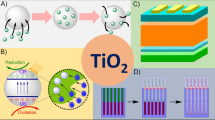Abstract
The electrokinetic properties of commercial titania and TiO2-SiO2 oxide composite, precipitated from an emulsion system with cyclohexane as the organic phase, are described. To extend the possible range of applications of the TiO2-SiO2 oxide composite, its surface was modified with selected alkoxysilanes: N-2-(aminoethyl)-3-aminopropyltrimethoxysilane, 3-methacryloxypropyltrimethoxysilane and vinyltrimethoxysilane. Modification with selected alkoxysilanes leads to the introduction of new chemical groups on the TiO2-SiO2 surface, which changes its initial properties and also the surface charge, manifested by the values of zeta potential. This study was undertaken to establish the effect of the type and amount of the modifier and type and ionic strength of the electrolyte on the zeta potential of the modified TiO2-SiO2 oxide composite and thus on the stability of the colloidal system. The powders were characterised by FTIR and elemental analysis to confirm the effectiveness of the surface modification. The structure of TiO2-SiO2 oxide composite was resolved by the wide-angle X-ray scattering method.










Similar content being viewed by others
References
Veronovski N, Andreozzi P, La Mesa C et al (2010) Stable TiO2 dispersions for nanocoating preparation. Surf Coat Technol 204:1445–1451
Panagiotou GD, Petsi T, Bourikas K et al (2008) Mapping the surface (hydr)oxo-groups of titanium oxide and its interface with an aqueous solution: the state of the art and a new approach. Adv Colloid Interface Sci 142:20–42
Ridley MK, Hackley VA, Machesky ML (2006) Characterization and surface-reactivity of nanocrystalline anatase in aqueous solutions. Langmuir 22:10972–10982
Chun H, Yizhong W, Hongxiao T (2001) Preparation and characterization of surface bond-conjugated TiO2/SiO2 and photocatalysis for azo dyes. Appl Catal, B 30:277–285
Xu Y, Langford CH (1997) Photoactivity of titanium dioxide supported on MCM41, zeolite X, and zeolite Y. J Phys Chem B 101:3115–3125
Murashkevich AN, Lavitskaya AS, Alisienok OA et al (2009) Fabrication and properties of SiO2/TiO2 composites. Inorg Mater 45:1146–1152
Bellardita M, Addamo M, Di Paola A et al (2010) Photocatalytic activity of TiO2/SiO2 systems. J Hazard Mater 174:707–713
Nilchi A, Janitabar-Darzi S, Mahjoub AR et al (2010) New TiO2/SiO2 nanocomposites—phase transformations and photocatalytic studies. Colloids Surf A Physicochem Eng Aspects 361:25–30
Zhan S, Chen D, Jiao X et al (2007) Mesoporous TiO2/SiO2 composite nanofibers with selective photocatalytic properties. Chem Commun 20:2043–2045
Ren S, Zhao X, Zhao L et al (2009) Preparation of porous TiO2/silica composites without any surfactants. J Solid State Chem 182:312–316
Yaremko ZM, Tkachenko NH, Hellmann C et al (2006) Redispergation of TiO2 particles in aqueous solutions. J Colloid Interface Sci 296:565–571
Hunter RJ (1981) Zeta potential in colloid science. Academic, New York
Kosmulski M, Rosenholm JB (2004) High ionic strength electrokinetics of anatase in the presence of multivalent inorganic ions. Colloids Surf A Physicochem Eng Aspects 248:121–126
Kosmulski M, Gustafsson J, Rosenholm JB (1999) Ion specificity and viscosity of rutile dispersions. Colloid Polym Sci 277:550–556
Kosmulski M, Dukhin AS, Priester T et al (2003) Multilaboratory study of the shifts in the IEP of anatase at high ionic strengths. J Colloid Interface Sci 263:152–155
Kosmulski M (2002) The significance of the difference in the point of zero charge between rutile and anatase. Adv Colloid Interface Sci 99:255–264
Kosmulski M (2001) Chemical properties of material surfaces. Marcel Dekker, New York
Kosmulski M, Durand-Vidal S, Gustafsson J et al (1999) Charge interactions in semi-concentrated titania suspensions at very high ionic strengths. Colloids Surf A Physicochem Eng Aspects 157:245–259
Gustafsson J, Nordenswan E, Rosenholm JB (2003) Consolidation behaviour in sedimentation of TiO2 suspensions in the presence of electrolytes. J Colloid Interface Sci 258:235–243
Jesionowski T, Ciesielczyk F, Krysztafkiewicz A (2010) Influence of selected alkoxysilanes on dispersive properties and surface chemistry of spherical silica precipitated in emulsion media. Mater Chem Phys 119:65–74
Jesionowski T, Krysztafkiewicz A (2000) Comparison of the techniques used to modify amorphous hydrated silicas. J Non-Cryst Solids 277:45–57
Roy SK, Sengupta PK (1988) Electrical properties and the surface characteristics of lanthanum oxide/water interface. J Colloid Interface Sci 125:340–343
Janusz W, Gałgan A (2001) Electrical double layer at manganese oxides/1:1 electrolyte solution interface. Physicochem Probl Miner Process 35:31–41
Berendsen GE, de Golan L (1978) Preparation and chromatographic properties of some chemically bonded phases for reversed-phase liquid chromatography. J Liq Chromatogr 1:561–586
Ntalikwa JW, Bryant R, Zunzu JSM (2001) Electrophoresis of colloidal α-alumina. Colloid Polym Sci 279:843–849
Sonnefeld J (2001) On the influence of background electrolyte concentration on the position of the isoelectric point and the point of zero charge. Colloids Surf A Physicochem Eng Aspects 190:179–183
Johnson SB, Scales PJ, Healy TW (1999) The binding of monovalent electrolyte ions on a-alumina. I. Electroacoustic studies at high electrolyte concentrations. Langmuir 15:2836–2843
Acknowledgments
This work was supported by the Polish National Centre of Science research grant no. 2011/01/B/ST8/03961.
Author information
Authors and Affiliations
Corresponding author
Rights and permissions
About this article
Cite this article
Nowacka, M., Siwińska-Stefańska, K. & Jesionowski, T. Structural characterisation of titania or silane-grafted TiO2-SiO2 oxide composite and influence of ionic strength or electrolyte type on their electrokinetic properties. Colloid Polym Sci 291, 603–612 (2013). https://doi.org/10.1007/s00396-012-2762-3
Received:
Revised:
Accepted:
Published:
Issue Date:
DOI: https://doi.org/10.1007/s00396-012-2762-3




